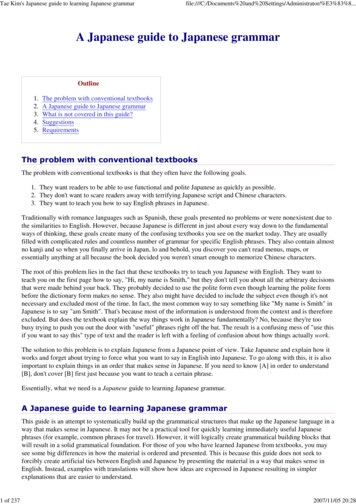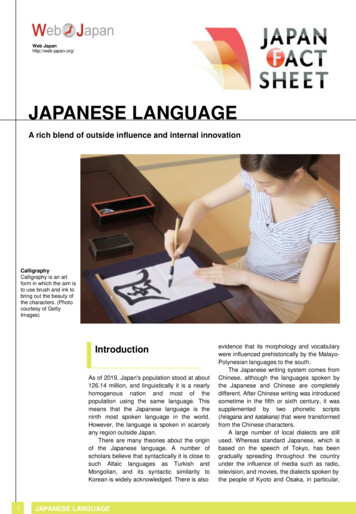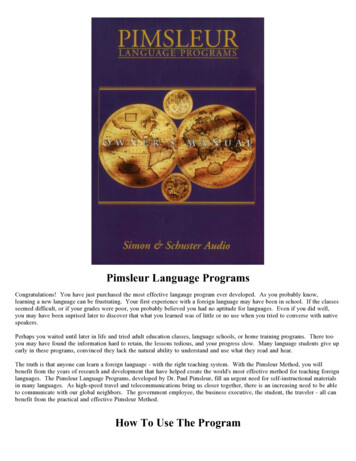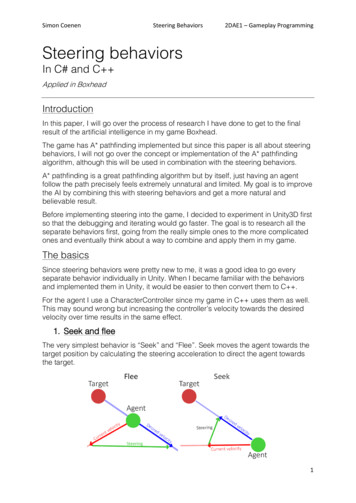
Transcription
SIMON & SCHUSTER’SPIMSLEUR JAPANESE1levelREADING BOOKLET
JAPANESE 1Travelers should always check with theirnation's State Department for currentadvisories on local conditions beforetraveling abroad.Graphic Design: Maia Kennedy and ‰ Recorded Program 2002 Simon & Schuster, Inc. Reading Booklet 2002 Simon & Schuster, Inc.Pimsleur is an imprint of Simon & Schuster Audio,a division of Simon & Schuster, Inc. Mfg. in USA.All rights reserved.ii
JAPANESE 1ACKNOWLEDGMENTSVoicesEnglish-Speaking Instructor . . . . . . . . . . . . . . . . Ray BrownJapanese-Speaking Instructor . . . . . . . . . . Makoto TakenakaFemale Japanese Speaker . . . . . . . . . . . Kimiko Ise AbramoffMale Japanese Speaker . . . . . . . . . . . . . . . . . Tsunenori AbeCourse WritersKimiko Ise Abramoff Beverly D. HeinleEditorsMiho Hirohashi Mary E. GreenNotes on Japanese Culture & CommunicationDr. Akira MiyaharaProfessor of Communication StudiesSeinan Gakuin UniversityExecutive ProducerBeverly D. HeinleProducer & DirectorSarah H. McInnisRecording EngineersPeter S. Turpin Kelly SauxSimon & Schuster Studios, Concord, MAiii
JAPANESE 1Table of ContentsNotes on Japanese Culture and Communication . . . . . . . . .1Lesson 1: sumimasen . . . . . . . . . . . . . . . . . . . . . . . . . . 3Word Order . . . . . . . . . . . . . . . . . . . . . . . . . . 3Lesson 2: Expressions of Modesty and Deferencein Japanese Communication . . . . . . . . . . . . . 4 ne . . . . . . . . . . . . . . . . . . . . . . . . . . . . . . . . 5Lesson 3: Omission of Subjects . . . . . . . . . . . . . . . . . . 5domo . . . . . . . . . . . . . . . . . . . . . . . . . . . . . . . 6Lesson 4: Questions Phrased with a Negative . . . . . . . . 6Public Transportation . . . . . . . . . . . . . . . . . . . 7Lesson 5: Language of Social Levels, Age,Position and Deference . . . . . . . . . . . . . . . . . 8nanika . . . . . . . . . . . . . . . . . . . . . . . . . . . . . . 8Lesson 6: Particles . . . . . . . . . . . . . . . . . . . . . . . . . . . . 9Lesson 7: Cognates and “Borrowed EnglishLoan Words” . . . . . . . . . . . . . . . . . . . . . . . . . 10Lesson 8: Addressing People . . . . . . . . . . . . . . . . . . . . 11Counting Things . . . . . . . . . . . . . . . . . . . . . . 11Lesson 9: Meals of a Day . . . . . . . . . . . . . . . . . . . . . . . 12Circumlocution . . . . . . . . . . . . . . . . . . . . . . . .13Lesson 10: Levels of Politeness . . . . . . . . . . . . . . . . . . . 14Lesson 11: chotto . . . . . . . . . . . . . . . . . . . . . . . . . . . . . . 15 masen ka? . . . . . . . . . . . . . . . . . . . . . . . . . 15Lesson 12: Yen: Japanese Currency . . . . . . . . . . . . . . . . 16Using a Telephone in Japan . . . . . . . . . . . . . 17Lesson 13: Counting in Japanese . . . . . . . . . . . . . . . . . . 18Good-bye . . . . . . . . . . . . . . . . . . . . . . . . . . . 18iv
JAPANESE 1Table of ContentsLesson 14: takusan, sukoshi . . . . . . . . . . . . . . . . . . . . . .Drinks . . . . . . . . . . . . . . . . . . . . . . . . . . . . . .Lesson 15: itte kimasu . . . . . . . . . . . . . . . . . . . . . . . . . . .Lesson 16: desu ga. . . . . . . . . . . . . . . . . . . . . . . . . . . .Lesson 17: kyo wo nani o shimasu ka? . . . . . . . . . . . . . .Lesson 18: shujin, goshujin / kanai, okusan . . . . . . . . . .Lesson 19: hajimemashite / dozo yoroshiku . . . . . . . . . .Lesson 20: hitori, futari, san nin . . . . . . . . . . . . . . . . . . .otoko no ko, onna no ko . . . . . . . . . . . . . . . .Lesson 21: otearai, toire . . . . . . . . . . . . . . . . . . . . . . . . .ah, so desu ka? . . . . . . . . . . . . . . . . . . . . . . .Lesson 22: kodomo, kodomo san . . . . . . . . . . . . . . . . . .Lesson 23: Weights and Measures . . . . . . . . . . . . . . . . .Lesson 24: Getting Around in Japan . . . . . . . . . . . . . . . .Lesson 25: oo kei . . . . . . . . . . . . . . . . . . . . . . . . . . . . . .Store Hours . . . . . . . . . . . . . . . . . . . . . . . . . .Lesson 26: ni, san . . . . . . . . . . . . . . . . . . . . . . . . . . . . . .Taxis in Japan . . . . . . . . . . . . . . . . . . . . . . . .Lesson 27: hyaku . . . . . . . . . . . . . . . . . . . . . . . . . . . . . .Lesson 28: jaa . . . . . . . . . . . . . . . . . . . . . . . . . . . . . . . . .Lesson 29: masu, mashita, masen . . . . . . . . . . . . . . . . . .Lesson 30: Continuing Success . . . . . . . . . . . . . . . . . . duction to Reading Japanese . . . . . . . . . . . . . . . . . .Kanji, the Chinese Characters . . . . . . . . . . . . . . . . . . . . .Katakana and Hiragana . . . . . . . . . . . . . . . . . . . . . . . . . .Books and Signs . . . . . . . . . . . . . . . . . . . . . . . . . . . . . . .35353841v
For more information,call 1-800-831-5497or visit us at Pimsleur.com
JAPANESE 1Notes on Japanese Culture and CommunicationThe objective of Pimsleur’s Japanese 1, is to introduceyou to the language and culture of Japan primarily throughyour ears, and only secondarily through your eyes.This approach is based upon the fact that more than 95percent of our lives is spent in listening and talking, and lessthan 5 percent in reading and writing. The most effectiveand productive way to begin acquiring these necessarycommunication skills is by actually working with the“language in use,” as demonstrated by native speakers of thelanguage being learned.Efficiency is greatly increased when what you learnfirst are the most-frequently-used structures and daily lifevocabulary, so that you practice with the practical tools yourequire every day. This carefully selected “core-language”allows the tutor to keep you focused entirely on essentiallanguage. This is self-motivating because you will begin touse it immediately and successfully.Language and culture are so closely intertwined thatlearning them separately can make you literally “culturallydeprived,” that is, unable to produce appropriate andmeaningful language. For this reason you must carefullynotice the different ways the Japanese “act” in the varioussituations you will experience as you proceed through thelessons of this course. Being sensitive to “who is doing whatto whom, and why,” is what you have learned to do almostunconsciously in your native tongue — you will attain this
JAPANESE 1same sense of “awareness” as you gain proficiency in yournew language. This implicit instruction will come from thelessons, as you learn to identify the intonation and melody ofthe speakers. This Booklet will provide additional explicitinstruction to further confirm what you have learned. TheNotes have also been recorded at the end of the program.Acquiring the culture, “the map of the territory,” is likeacquiring the terminology of a subject: it enables you tooperate as a fellow member in that society. Your successin working with native speakers of Japanese will dependto some extent upon how sensitive you become to theaccumulated heritage that is Japanese.2
JAPANESE 1Lesson 1: sumimasenIn this lesson, you have learned sumimasen for“Excuse me.” You will find yourself using and hearingthis expression quite often in your interactions with theJapanese. sumimasen is used for several purposes. Itis often used to express the speaker’s sincere and politeattitude toward others. However, Japanese people usethis expression to convey not only “Excuse me,” butalso “I’m sorry,” and even “Thank you.” You will hearthem say sumimasen to attract someone’s attention wheninitiating a conversation, as was demonstrated in thelesson. You might also hear this expression from someonewho mistakenly steps on your foot in a crowded train andwishes to apologize. It is a very useful expression in awide range of social contexts.Word OrderYou noticed in this lesson that the Japanese word order isvery different from what you are accustomed to in English.Such words as masu, masen, and masu ka — which determinewhether the speaker is making a statement, negating orasking something — come at the end of a sentence. Youneed to, therefore, listen to the speaker all the way throughto the end of the sentence to find out the speaker’s intention.This may be confusing to you at first, but as you becomeskillful, you will be able to use this sentence structure toyour advantage, as you can carefully sense the listener’sfeeling while you speak. You can then decide on the overalltone of your message by modifying the ending accordingly.3
JAPANESE 1Lesson 2Expressions of Modesty and Deferencein Japanese CommunicationIn this lesson you heard a person expressing modestywhen receiving a compliment from another person onhis ability to speak Japanese. When someone compliments the Japanese on good work, nice clothes, a beautifulhouse, a wonderful dinner, etc., it is customary for themto downplay their abilities, possessions, etc. Whilenegating a compliment may be considered a sign of lackof confidence or even insincerity in some cultures, theJapanese frequently use it as an expression of modestyand deference in daily communication. As a case in point,consider this conversation:“That was a wonderful meal! You are a greatcook, suzuki san.”“Oh, no. I only followed a recipe. Anybodycan cook.”“I certainly can’t. Could you teach me?”“Can I teach? Oh, no. You cook far betterthan I can. I’m the one who needs to takelessons from you.Suzuki may be seen as too modest by American standards,but this is socially acceptable behavior in Japan. Thishumility is only seen as avoiding appearing to be arrogantor conceited.4
JAPANESE 1 neIn this lesson you also heard ne at the end of sentences, asin nihongo ga wakarimasu ne. It is roughly equivalent to theEnglish “isn’t it?” “aren’t you?” “don’t you?” etc. The useof ne shows that the speaker expects the listener to agree withhim or her. You will hear this used frequently in Japanese;in fact, some people may end virtually every sentence withne. Living in a more collectivistic society than the U.S.,the Japanese value being aligned with and maintainingharmonious relationships with others. The frequent use ofne illustrates their desire to avoid creating any potential forconflict or disagreement with one another.Lesson 3: Omission of SubjectsJapanese speakers often rely on the listener’s abilityto understand their real intention from what appears to besubtle and evasive verbal and nonverbal signals. Being ableto leave some things unsaid so that the other can read betweenthe lines is an important skill in Japanese communication.A person who explains things in great detail is consideredlegalistic and is often frowned upon. The frequent omissionof subjects is one example of this ambiguous and seeminglyincomplete form of Japanese communication. This style ofspeech may frustrate foreign learners of Japanese at first, butafter a while it will become natural.5
JAPANESE 1The Japanese language has several words for “you.” Theone to use depends upon the speaker’s relationship with theperson being spoken to. Among these are the common anata,which was introduced in this lesson, the informal anta, theformal kimi (often used by a superior to address his or herjunior), and omae, used only by male speakers. However,you will often hear people address one another without usingany of these, simply leaving “you” to be understood.domodomo is used to emphasize your politeness, as in domoarigato gozaimasu. It is used for a variety of purposes: toindicate “indeed” and “very much” as in this lesson, to showthe speaker’s suspicious feeling as in domo okashii, “I have adoubt about it,” or to mean “by any means.” Japanese speakersare very fond of using domo in many contexts. Althoughin formal, “correct” speech, domo should be followed by aword that it modifies, Japanese speakers often use it alone.You will often hear them say domo, domo when they greeteach other.Lesson 4: Questions Phrased with a NegativeWhen speaking to Japanese speakers and phrasing aquestion with a negative such as “Aren’t you tired?” or “Isn’t ithot today?” you will find that they will sometimes reverse “yes”and “no.” For example, when asked “Aren’t you Japanese?”they will answer “No,” meaning “I am Japanese.” Sincebeing able to read another person’s implications and behaving6
JAPANESE 1accordingly is an important social skill in Japan, when asked“Aren’t you Japanese?” many Japanese people will assumethat you must be thinking he or she is not Japanese. In responseto this assumption, they will deny, by saying “No,” meaning,“No, you are wrong, I am indeed Japanese.” That is why, in theconversation the person said iie, yoku hanasemasu (“No, youcan speak well”) in response to demo, mada jozu ja arimasen(“But I can’t speak well yet”).Public TransportationIn this lesson, you heard the names of two places in Tokyo:Ueno and Shinjuku. These are both very busy districts, sincethey are the hubs of major railroad and subway lines, servingmillions of people every day who travel to, from, and aroundthe Tokyo metropolitan area. There are numerous nationaland private railroad companies and some fifteen subwaylines in Tokyo, and they are still being further developed.The complex subway lines make it quite challenging forinternational travelers, and some-times the local residents aswell, to figure out the best way to travel to their destinations.You may sometimes get an uncertain response or noresponse at all when you ask passers-by in downtown Tokyofor directions. The public transportation system in Japan isgenerally well developed, but in order to take full advantageof it, you need to first memorize the names of major citiesand towns that will help orient you to the right directions andthe best method of transportation.7
JAPANESE 1Lesson 5Language of Social Levels, Age,Position, and DeferenceThe complex rules governing status in Japan play animportant role in the expressions used in various socialsituations. In this lesson, you have learned how to ask aperson whether he or she wa
The objective of Pimsleur’s Japanese 1, is to introduce you to the language and culture of Japan primarily through your ears, and only secondarily through your eyes. This approach is based upon the fact that more than 95 percent of our lives is spent in listening and talking, and less than 5 percent in reading and writing. The most effective and productive way to begin acquiring these .











